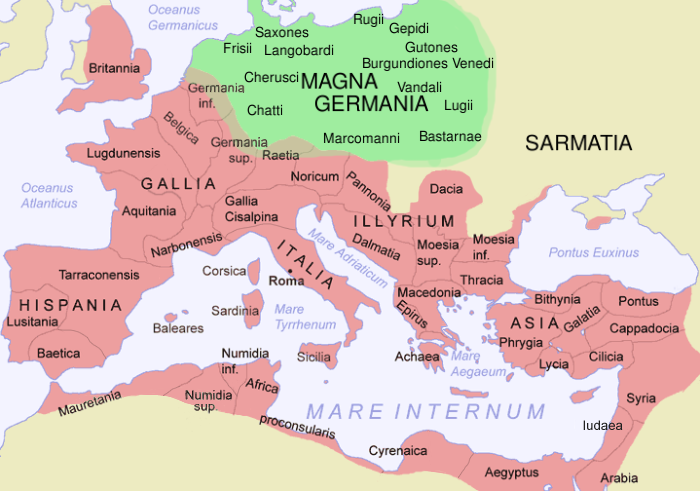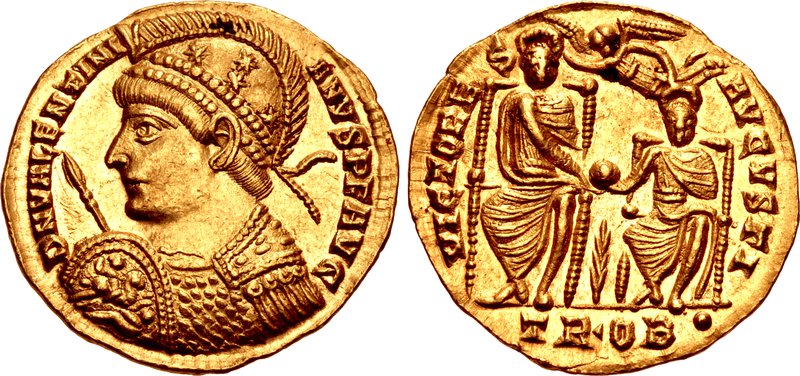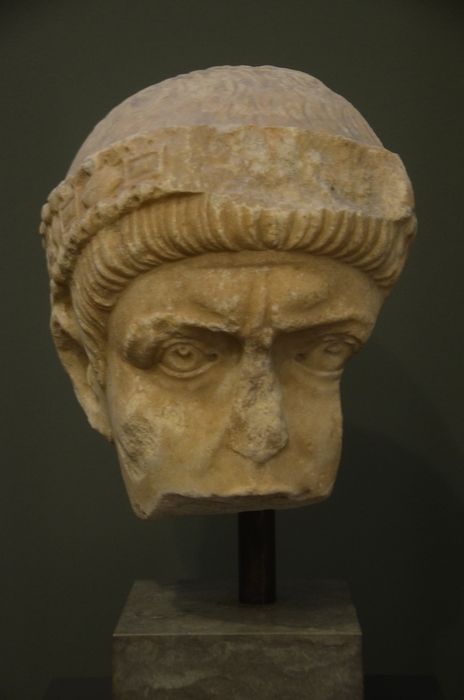|
Valens
Valens ( grc-gre, Ουάλης, Ouálēs; 328 – 9 August 378) was Roman emperor from 364 to 378. Following a largely unremarkable military career, he was named co-emperor by his elder brother Valentinian I, who gave him the eastern half of the Roman Empire to rule. In 378, Valens was defeated and killed at the Battle of Adrianople against the invading Goths, which astonished contemporaries and marked the beginning of barbarian encroachment into Roman territory. As emperor, Valens continually faced threats both internal and external. He defeated, after some dithering, the usurper Procopius (usurper), Procopius in 366, and campaigned against the Goths across the Danube in 367 and 369. In the following years, Valens focused on the eastern frontier, where he faced the perennial threat of Sasanian Empire, Persia, particularly in Kingdom of Armenia (antiquity), Armenia, as well as additional conflicts with the Saracens and Isaurians. Domestically, he inaugurated the Aqueduct of ... [...More Info...] [...Related Items...] OR: [Wikipedia] [Google] [Baidu] |
Valentinianic Dynasty
The Valentinianic or Valentinian dynasty was a ruling house of five generations of dynasts, including five Roman emperors during Late Antiquity, lasting nearly a hundred years from the mid fourth to the mid fifth century. They succeeded the Constantinian dynasty () and reigned over the Roman Empire from 364 to 392 and from 425 to 455, with an interregnum (392–423), during which the Theodosian dynasty ruled and eventually succeeded them. The Theodosians, who intermarried into the Valentinian house, ruled concurrently in the east after 379. The Valentinian dynasty's patriarch was Gratianus Funarius, whose sons Valentinian I and Valens were both made Roman emperors in 364. Valentinian I's two sons, Gratian and Valentinian II both became emperors. Valentinian I's daughter Galla married Theodosius the Great, the emperor of the eastern empire, who with his descendants formed the Theodosian dynasty (). In turn, their daughter, Galla Placida married a later emperor, Constantius I ... [...More Info...] [...Related Items...] OR: [Wikipedia] [Google] [Baidu] |
Battle Of Adrianople
The Battle of Adrianople (9 August 378), sometimes known as the Battle of Hadrianopolis, was fought between an Eastern Roman army led by the Eastern Roman Emperor Valens and Gothic rebels (largely Thervings as well as Greutungs, non-Gothic Alans, and various local rebels) led by Fritigern. The battle took place in the vicinity of Adrianople, in the Roman province of Thracia (modern Edirne in European Turkey). It ended with an overwhelming victory for the Goths and the death of Emperor Valens.Zosimus, ''Historia Nova'', book 4. As part of the Gothic War (376–382), the battle is often considered the start of the events which led to the fall of the Western Roman Empire in the 5th century. A detailed contemporary account of the lead-up to the battle from the Roman perspective was written by Ammianus Marcellinus and forms the culminating point at the end of his history. Background In 376, the Goths, led by Alavivus and Fritigern, asked to be allowed to settle in the Ea ... [...More Info...] [...Related Items...] OR: [Wikipedia] [Google] [Baidu] |
Gratian
Gratian (; la, Gratianus; 18 April 359 – 25 August 383) was emperor of the Western Roman Empire from 367 to 383. The eldest son of Valentinian I, Gratian accompanied his father on several campaigns along the Rhine and Danube frontiers and was raised to the rank of ''Augustus'' in 367. Upon the death of Valentinian in 375, Gratian took over government of the west while his half-brother Valentinian II was also acclaimed emperor in Pannonia. Gratian governed the western provinces of the empire, while his uncle Valens was already the emperor over the east. Gratian subsequently led a campaign across the Rhine, attacked the Lentienses, and forced the tribe to surrender. That same year, the eastern emperor Valens was killed fighting the Goths at the Battle of Adrianople, which led to Gratian elevating Theodosius to replace him in 379. Gratian favoured Nicene Christianity over traditional Roman religion, issuing the Edict of Thessalonica, refusing the office of '' pontifex maximus ... [...More Info...] [...Related Items...] OR: [Wikipedia] [Google] [Baidu] |
Aqueduct Of Valens
The Aqueduct of Valens ( tr, Valens Su Kemeri, grc, Ἀγωγὸς τοῦ ὕδατος, translit=Agōgós tou hýdatos, lit=aqueduct) was a Roman aqueduct system built in the late 4th century AD, to supply Constantinople – the capital of the eastern Roman empire. Construction of the aqueduct began during the reign of the Roman emperor Constantius II () and was completed in 373 by the emperor Valens (). The aqueduct remained in use for many centuries. It was extended and maintained by the Byzantines and the Ottomans. Initially, the Aqueduct of Valens carried water from springs at Danımandere and Pınarca; the channels from each spring met at Dağyenice. This 4th-century first phase of the system was long. A second, 5th-century phase added a further of conduits that took water from Vize, away from Constantinople. The final and most visible aqueduct bridge in the system survives in the Fatih district of Istanbul, Turkey. Named in , it is an important landmark in the cit ... [...More Info...] [...Related Items...] OR: [Wikipedia] [Google] [Baidu] |
Domnica
Domnica ( 378) was the wife of Roman emperor Valens. Valens, who ruled from 364 to 378, was emperor of the East and co-emperor with his brother Valentinian I. After the death of her husband in 378 she ruled as ''de facto'' regent and defended Constantinople against the attacking Goths until his successor, Theodosius I arrived. Family Dominica was the daughter of the powerful and unpopular praetorian prefect Petronius, who was hated for his greed and cruelty. Her father's unpopularity was so great that it led to the rebellion of Procopius, a rival of Valens, in 365. According to the account of Ammianus Marcellinus: "To the emperor's cruelty deadly incentive was given by his father-in‑law Petronius, who from the command of the Martensian legion had by a sudden jump been promoted to the rank of patrician. He was a man ugly in spirit and in appearance, who, burning with an immoderate longing to strip everyone without distinction, condemned guilty and innocent alike, after exqu ... [...More Info...] [...Related Items...] OR: [Wikipedia] [Google] [Baidu] |
Valerius Valens
Aurelius Valerius Valens (died 317), rarely Valens I, was briefly Roman emperor from late 316 to early 317. He was proclaimed emperor by Licinius, emperor of the East, during his war against Constantine I, emperor of the West. Biography In 316 Valens held the position of '' dux limitis'' ("duke of the frontier") in Dacia. On October 8, Constantine I, who controlled the west, won a overwhelming victory at the Battle of Cibalae against Licinius, his co-emperor in the East. The battle is sometimes dated to 314, but contemporary sources indicate that it occurred in 317. Licinius fled to Sirmium where, with the help of Valens, he gathered a second army. He gave Valens the rank of ''augustus'' (emperor), probably to replace Constantine in the West. Literary sources refer to Valens only as ''caesar'' (heir apparent), but numismatic evidence clearly indicates that he was ''augustus''. Valens adopted the name "Valerius", as was customary among the Tetrarchs. According to Petrus P ... [...More Info...] [...Related Items...] OR: [Wikipedia] [Google] [Baidu] |
Valentinian I
Valentinian I ( la, Valentinianus; 32117 November 375), sometimes called Valentinian the Great, was Roman emperor from 364 to 375. Upon becoming emperor, he made his brother Valens his co-emperor, giving him rule of the eastern provinces. Valentinian retained the west. During his reign, Valentinian fought successfully against the Alamanni, Quadi, and Sarmatians. Most notable was his victory over the Alamanni in 367 at the Battle of Solicinium. His general Count Theodosius defeated a revolt in Africa and the Great Conspiracy, a coordinated assault on Roman Britain by Picts, Scots, and Saxons. Valentinian was also the last emperor to conduct campaigns across both the Rhine and Danube rivers. Valentinian rebuilt and improved the fortifications along the frontiers, even building fortresses in enemy territory. He founded the Valentinianic dynasty, with his sons Gratian and Valentinian II succeeding him in the western half of the empire. Early life Valentinian was born i ... [...More Info...] [...Related Items...] OR: [Wikipedia] [Google] [Baidu] |
Valentinianus Galates
Valentinianus Galates (Greek: Ούαλεντινιανός Γαλάτης, 18 January 366 – ) was the only son of the Roman emperor Valens (), who ruled the Roman Empire during Late Antiquity. Born into the ruling Valentinianic dynasty, Valentinianus became Roman consul as an infant, but he died in early childhood, and the empire passed to the sons and daughter of Valentinian the Great (), Valentinianus Galates's uncle. According to the 4th- and 5th-century ecclesiastical histories written by Nicene Christians, Valentinianus died as a result of his father's Arian Christianity. Life Valentinianus was the third child of the emperor Valens and the ''augusta'' Albia Dominica, their only son. According to the ''Consularia Constantinopolitana'', Valentinianus was born on 18 January 366. According to the work of the contemporary orator Themistius, he was born beside the Danube, where the Danubian ''Limes'' marked the frontier of the empire. He was possibly born in Galatia, which w ... [...More Info...] [...Related Items...] OR: [Wikipedia] [Google] [Baidu] |
Procopius (usurper)
Procopius (Ancient Greek: Προκόπιος) (c. 325/326 – 27 May 366 AD) was a Roman usurper against Valens, and a member of the Constantinian dynasty. Life Procopius was a native of Cilicia born in Corycus. On his mother's side, Procopius was a Greek, a maternal cousin, to Emperor Julian, since their maternal grandfather was Julius Julianus. His first wife was probably Artemisia, having married secondly the dowager Empress Faustina, while the Roman general of the 5th century Procopius and his son, the Emperor Anthemius, were among his descendants, the first being the son of his son Procopius. In 358, during the reign of Constantius II, he was sent with Lucillianus as an envoy to the Sassanid court; in this period he was ''tribunus'' and ''notarius''.Ammianus Marcellinus, XXVI.6.1. Procopius entered Julian's retinue and took part in his campaign against the Sassanids in 363. Together with Sebastianus he was entrusted with controlling the upper Tigris with 30,000 men ... [...More Info...] [...Related Items...] OR: [Wikipedia] [Google] [Baidu] |
Goths
The Goths ( got, 𐌲𐌿𐍄𐌸𐌹𐌿𐌳𐌰, translit=''Gutþiuda''; la, Gothi, grc-gre, Γότθοι, Gótthoi) were a Germanic people who played a major role in the fall of the Western Roman Empire and the emergence of medieval Europe. In his book '' Getica'' (c. 551), the historian Jordanes writes that the Goths originated in southern Scandinavia, but the accuracy of this account is unclear. A people called the '' Gutones''possibly early Gothsare documented living near the lower Vistula River in the 1st century, where they are associated with the archaeological Wielbark culture. From the 2nd century, the Wielbark culture expanded southwards towards the Black Sea in what has been associated with Gothic migration, and by the late 3rd century it contributed to the formation of the Chernyakhov culture. By the 4th century at the latest, several Gothic groups were distinguishable, among whom the Thervingi and Greuthungi were the most powerful. During this time, W ... [...More Info...] [...Related Items...] OR: [Wikipedia] [Google] [Baidu] |
Valentinian II
Valentinian II ( la, Valentinianus; 37115 May 392) was a Roman emperor in the western part of the Roman empire between AD 375 and 392. He was at first junior co-ruler of his brother, was then sidelined by a usurper, and only after 388 sole ruler, albeit with limited ''de facto'' powers. A son of emperor Valentinian I and empress Justina, he was raised to the imperial office at the age of 4 by military commanders upon his father's death. Until 383, Valentinian II remained a junior partner to his older half-brother Gratian in ruling the Western empire, while the East was governed by his uncle Valens until 378 and Theodosius I from 379. When Gratian was killed by the usurper emperor Magnus Maximus in 383, the court of Valentinian in Milan became the center of Italy where several religious debates took place. In 383, Maximus invaded Italy, spurring Valentinian and his family to escape to Thessalonica where they successfully sought Theodosius' aid. Theodosius defeated Maximus in batt ... [...More Info...] [...Related Items...] OR: [Wikipedia] [Google] [Baidu] |
Theodosius I
Theodosius I ( grc-gre, Θεοδόσιος ; 11 January 347 – 17 January 395), also called Theodosius the Great, was Roman emperor from 379 to 395. During his reign, he succeeded in a crucial war against the Goths, as well as in two civil wars, and recognized the Catholic orthodoxy of Nicene Christians as the Roman Empire's state religion. Theodosius was the last emperor to rule the entire Roman Empire before its administration was permanently split between two separate courts (one western, the other eastern). Born in Hispania, Theodosius was the son of a high-ranking general, Theodosius the Elder, under whose guidance he rose through the ranks of the Roman Army. Theodosius held independent command in Moesia in 374, where he had some success against the invading Sarmatians. Not long afterwards, he was forced into retirement, and his father was executed under obscure circumstances. Theodosius soon regained his position following a series of intrigues and execu ... [...More Info...] [...Related Items...] OR: [Wikipedia] [Google] [Baidu] |






.jpg)
